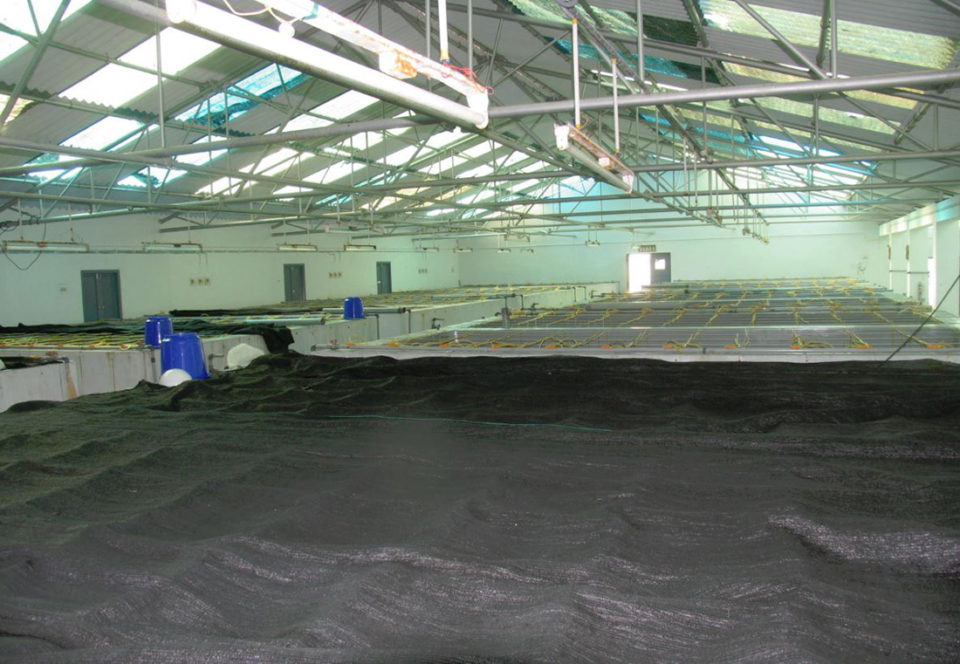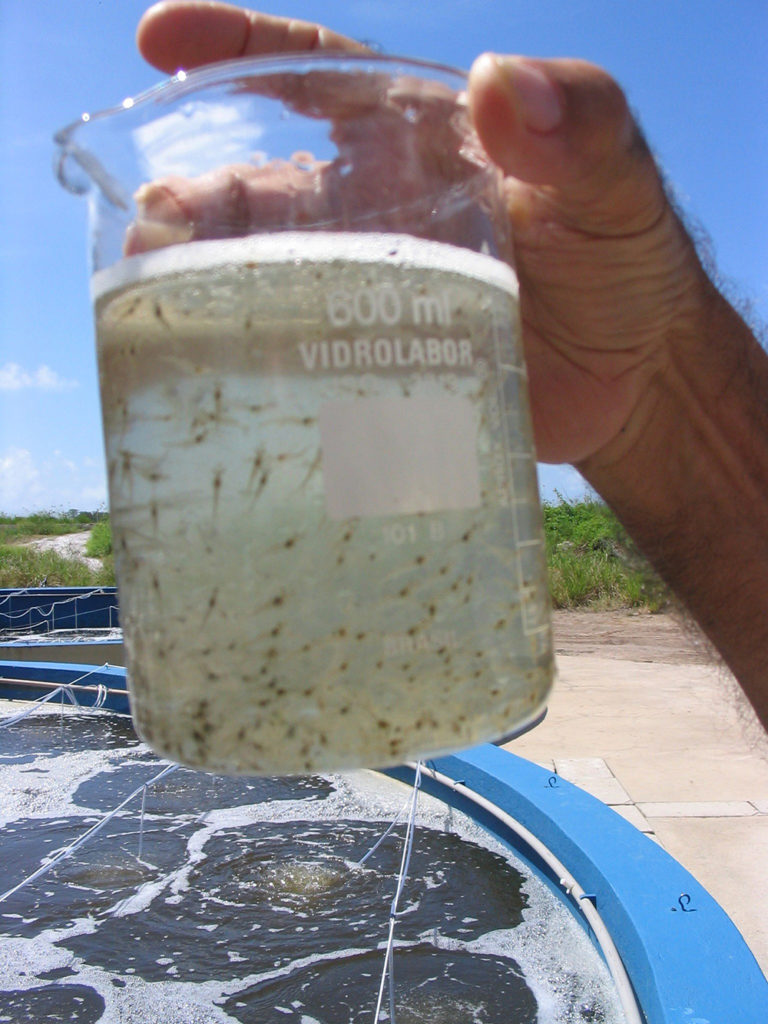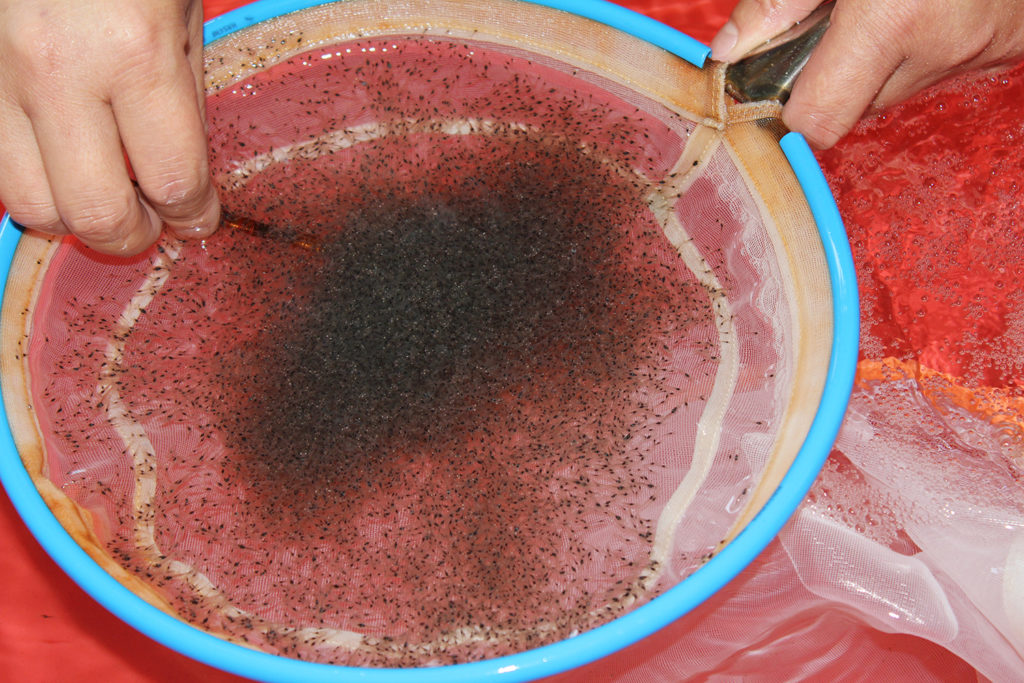Perspectives and recommendations for Pacific white shrimp culture

Editor’s note: This is part 3 of a three-part series. Read part 1 here and part 2 here.
Perspectives
Currently, shrimp hatcheries in India depend exclusively on imported SPF P. vannamei broodstock for seed production. In recent years, the Zoea-2 Syndrome has emerged as a major challenge for P. vannamei aquaculture, causing serious economic consequences for shrimp hatchery operators. During our study, of fifteen commercial shrimp hatcheries in Tamil Nadu and Andhra Pradesh, nine hatcheries were affected with the Zoea-2 Syndrome. We observed that gradual progressive mortalities have been cumulatively recurring between 30 to 100 percent in the zoea stages at P. vannamei shrimp hatcheries in India.
Generally, the most critical stage in shrimp larval rearing is that of the nauplii VI-zoea I. In the stage Z I, the zoea begin extensive feeding, mainly on microalgae. Healthy zoea feed actively and have a full intestine without abnormalities.
After 36 to 48 hours of zoea I, affected larvae suddenly stop feeding, develop systemic abnormalities and suffer mortalities. The consistent symptoms of non-feeding – as well as lethargy – in the affected larvae could be related to the lack of adequate nutrition during larval metamorphosis, which can further hinder successful larval development during the larval cycle and could lead to poor survival.
Microscopic and ultrastructural studies revealed underlying pathological changes in the digestive system and associated organs, particularly in the hepatopancreas and the intestine, which resulted in the deterioration of nutrient absorption and hunger in affected animals. This deterioration in nutrient uptake could lead to decreased activity, late molting and mortality in larvae affected by Zoea-2 Syndrome, as reported elsewhere for the larvae of a palaemonid shrimp, where starvation significantly affected growth and development.
During the Zoea-2 Syndrome, the detachment of microvilli and epithelial cells appear in the hepatopancreas, as well as inflammation and desquamation of the epithelial cells in the intestinal epithelium, pointing to an underlying pathological process.
Ultra-structural and PCR studies did not reveal the presence of pathogens, including the known shrimp DNA and RNA viruses, in the affected zoea. A considerably higher association during the microbial investigation was observed with Vibrio alginolyticus in the larvae affected by the Zoea-2 Syndrome. However, its role as a pathogen could not be explained, because it is also associated as part of the natural flora of healthy larvae.
Its association with Zoea-2 Syndrome was highlighted in many previous studies, but its role in larval mortality due to this syndrome is not yet clear. Several authors have described the association of V. alginolyticus in penaeids and non-penaeids – and also Macrobrachium rosenbergii – and larval mortality due to the resistance of V. alginolyticus to antibiotics.
With the appearance of vibriosis in both healthy and diseased animals, the hypothesis of the opportunistic nature of vibriosis in penaeid shrimp is widely accepted. Our study indicates that the Zoea-2 Syndrome is possibly due to the accumulated conditions in the larval rearing tanks during the larval cycles, even with constant and uniform water quality parameters and management practices.
In addition, the Zoea-2 Syndrome seems to be related to a prolonged production cycle in hatcheries, and to a continuous average of more than three to four days in the same larval rearing units – these could be probable causes of the incidence of Zoea-2 Syndrome. Since this syndrome was not observed in the fresh larval units of the hatchery, its incidence was probably caused by the cumulative effect of unknown factors, which have been accumulated during the larval cycles in the affected hatcheries.
In this study, we also observed that the lack of adequate disinfection both during and between larval production cycles – without ignoring the lack of separate units – would be another of the other factors predisposing the appearance of the Zoea-2 Syndrome. In almost all commercial shrimp hatcheries, the bacterial load was increased despite following extensive water treatment with sand filters, cartridge filters, UV filters and chlorination during the larval production cycle.
Vibrios that are opportunistic pathogens cause infections resulting in late molting by three to four days, and mortality of zoea in the stage of zoea-2 due to negligent management. Economic losses due to the Zoea-2 Syndrome in a hatchery with a capacity of 100 million nauplii are estimated at approximately $18,000 to $61,000 (12 to 40 lakhs, Indian rupees). Larval production depends totally imported SPF broodstock, which increases the cost of seed production.
Recommendations
Ensuring strict good management practices involves following various procedures. Implement the appropriate disinfection periods in addition to an interval between larval production cycles. Consider reducing the number of days of storage of nauplii from typical periods of three to four days in the same unit. Improve algae quality using diluted series cultivation and circulation systems. Consider physically separating maturation, spawning, larvae rearing and algae cultivation (indoor and outdoor) units. Include separate water-air supply units, and keep workers and their implements separated for each unit.
The recommendations presented would help reduce the incidence of Zoea-2 Syndrome. Our study revealed that Zoea-2 Syndrome in P. vannamei hatcheries is not caused by any known infectious agents. There are indicators of deterioration of the digestive system in zoea, and of unknown factors that affect the zoeal metamorphosis. A follow-up multidimensional and integrative research that also involves zoeal physiological factors would be useful to understand the causes of the deterioration of the digestive system in addition to the role of opportunistic pathogens.
Authors
-
Sathish Kumar
ICAR-Central Institute of Brackishwater Aquaculture
#75 Santhome High Road, Raja Annamalai Puram
Chennai 600028, India[110,105,46,115,101,114,46,97,98,105,99,64,116,114,97,109,117,107,104,115,105,104,116,97,115]
-
Vidya
ICAR-Central Institute of Brackishwater Aquaculture
#75 Santhome High Road, Raja Annamalai Puram
Chennai 600028, India -
Dr. Sujeet Kumar
ICAR-Central Institute of Brackishwater Aquaculture
#75 Santhome High Road, Raja Annamalai Puram
Chennai 600028, India -
Dr. S.V. Alavandi
ICAR-Central Institute of Brackishwater Aquaculture
#75 Santhome High Road, Raja Annamalai Puram
Chennai 600028, India -
Dr. K.K. Vijayan
ICAR-Central Institute of Brackishwater Aquaculture
#75 Santhome High Road, Raja Annamalai Puram
Chennai 600028, India
Tagged With
Related Posts

Health & Welfare
A study of Zoea-2 Syndrome in hatcheries in India, part 1
Indian shrimp hatcheries have experienced larval mortality in the zoea-2 stage, with molt deterioration and resulting in heavy mortality. Authors investigated the problem holistically.

Health & Welfare
A study of Zoea-2 Syndrome in hatcheries in India, part 2
Indian shrimp hatcheries have experienced larval mortality in the zoea-2 stage, with molt deterioration and resulting in heavy mortality. Authors considered biotic and abiotic factors. Part 2 describes results of their study.

Health & Welfare
How good are your shrimp postlarvae?
Stocking the best quality shrimp postlarvae, healthy and free of pathogens, is a critical management step with significant effects on the production and profitability of a shrimp farm.

Health & Welfare
A holistic management approach to EMS
Early Mortality Syndrome has devastated farmed shrimp in Asia and Latin America. With better understanding of the pathogen and the development and improvement of novel strategies, shrimp farmers are now able to better manage the disease.


